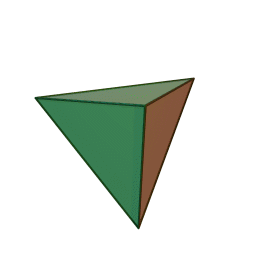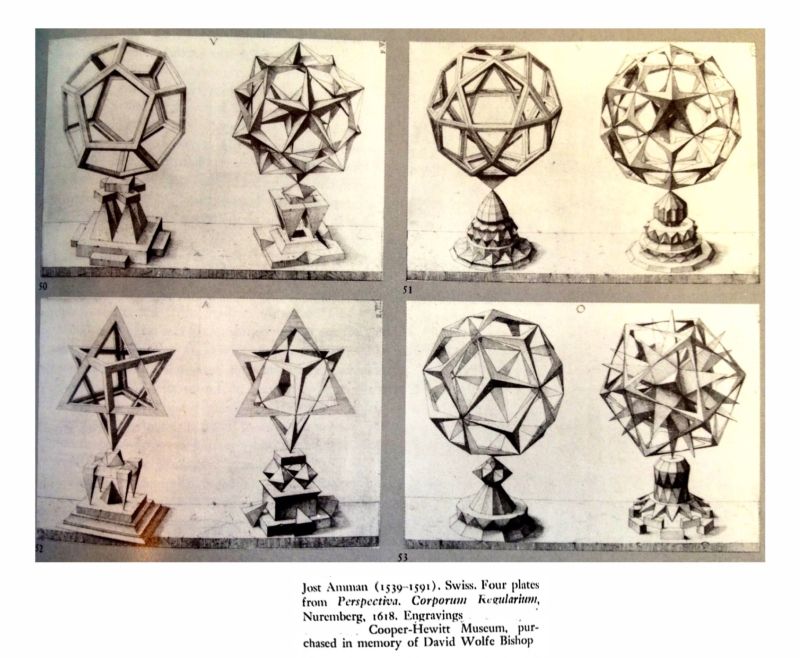THE PLATONIC SOLIDS
 |
| Cube with magic ribbons M.C. Escher |
A Platonic Solid is a three dimensional shape where
each face is the same regular polygon and the same number of polygons meet at each corner
For example a cube is a Platonic Solid because each side is made of an identical square and three squares meet at each corner.
The five platonic solids are:
Click here for a printable pattern to build your own tetrahedron
Click here for a printable pattern to build your own cube
Click here for a printable pattern to build your own octahedron
Click here for a printable pattern to build your own dodecahedron
Click here for a printable pattern to build your own icosahedron
Spinning forms courtesy of Wikimedia Commons
Design your own polyhedron by printing out and combining the geometry nets (paper patterns) above.
Common Core Math Standards for this activity:
6.G.4 - Represent three-dimensional figures using nets made up of rectangles and triangles
Examples of Platonic Solids and other polyhedra in art:
 |
| Reptiles M. C. Escher |
 |
| Metamorphosis I M. C. Escher |
 |
| Kepler's Platonic solid model of the Solar system, 1600 For more information about the platonic solids in art and architecture click here |
 |
Click here to read my post on tessellations and then
7) click here to find out how you can build a three-dimensional dodecahedron tessellation. Can you design and build tessellations out of the other platonic solids?
|
| Can you find a connection between the reason regular polygons can form tessellations and the reason they can form the five platonic solids? |
<>
| |||
Directions: Using 6 toothpicks and small, pea sized, pieces of Crayola Model Magic, create a model of a tetrahedron. If you don't have Model Magic you can create your own clay, using white bread and ordinary white glue. To learn how to make home made clay, click here. |

Add three more toothpicks to form a second tetrahedron.
Continue to add toothpicks, three at a time to build your structure.
Continue to add toothpicks, three at a time to build your structure.
Create a tower consisting entirely of tetrahedrons. See how tall a tower you can build.
Some other ideas:
Build a toothpick city with your friends.
Click here for some amazing toothpick city ideas.
Click here to find out how you can enter a toothpick sculpture building contest.
Click here for some amazing toothpick city ideas.
Click here to find out how you can enter a toothpick sculpture building contest.
Have a bridge building contest.
Click here and here for more information on bridge building in your classroom.
Click here to download free bridge design software from West Point Military Academy. Click here for information on West Point's annual bridge design contest.
To learn how to create a realistic drawing of a suspension bridge, using three-point perspective, click here.
Click here to see how students combined polyhedra to create some amazing structures
Watch this video to learn how one artist spent 35 years constructing a really cool toothpick sculpture of San Francisco. It all started when he was 8 years old and learned how to build toothpick sculptures in school.
Click here and here for more information on bridge building in your classroom.
Click here to download free bridge design software from West Point Military Academy. Click here for information on West Point's annual bridge design contest.
To learn how to create a realistic drawing of a suspension bridge, using three-point perspective, click here.
Click here to see how students combined polyhedra to create some amazing structures
Watch this video to learn how one artist spent 35 years constructing a really cool toothpick sculpture of San Francisco. It all started when he was 8 years old and learned how to build toothpick sculptures in school.
Where will your inspiration take you?
RELATED ART HISTORY
 |
| Monument to the Third International By Vladimir Tatlin |
Learn more about Vladimir Tatlin by clicking here
Tatlin conceived of the idea for the tower after visiting Paris.
He was inspired by seeing the Eiffel tower.
"The Eiffel Tower, Paris
"It was the tallest structure in the world from its completion until 1930, when it was eclipsed by the Chrysler Building in New York City
Before the Eiffel Tower
*(Information on the Eiffel Tower courtesy of www.wikipedia.org)Tatlin was also inspired by visiting Pablo Picasso in his studio in Paris.
 |
| Drawing of Paul Eluard by Pablo Picasso |
Picasso and his friend Georges Braque invented a type of art called ‘cubism’. This cubist drawing simplifies the human face into straight lines and geometric shapes
Once photography became widely available, artist no longer felt the need to faithfully copy nature. Instead they began to experiment and express their ideas in new ways. Many people thought Cubist pictures were ugly and did not like the new paintings.
 |
| Something to think about: Decades before the invention of the modern computer (or video game) Pablo Picasso and Georges Braque began simplifying the human face into straight lines and geometric forms, in much the same way 3D computer animators do today. Does technology inspire art or does art inspire technology? The answer is; both. The two are inseparable. To see how one contemporary artist used modern wire frame technology to create this three dimensional cubist style paper head click here. |
Questions for discussion:
1) Why do you think Tatlin's tower was never built?
2) What made the Constructivists different from other sculptors?
3) Why do you think a building might be more stable if the designer used triangular braces? How can triangular bracing keep a building from collapsing?
4) Describe the Geometric forms that Tatlin was planning to place within the tower. What shapes did he choose and what were they supposed to symbolize?
5) Where did the Constructivists get their ideas from?
6) At the time when Vladimir Tatlin designed his monument, what building was the tallest building in the world?
7) How do you think Gustave Eiffel was able to create such a tall building without it collapsing? What technique was used by both Vladimir Tatlin and Gustave Eiffel?
8) How big would the Monument to the Third International have been, had it been built?
9) What do you think would happen if you tried to build a tall toothpick structure out of cubes instead of tetrahedrons?
10) Give some examples of how artists can get ideas from other people who came before them.












































